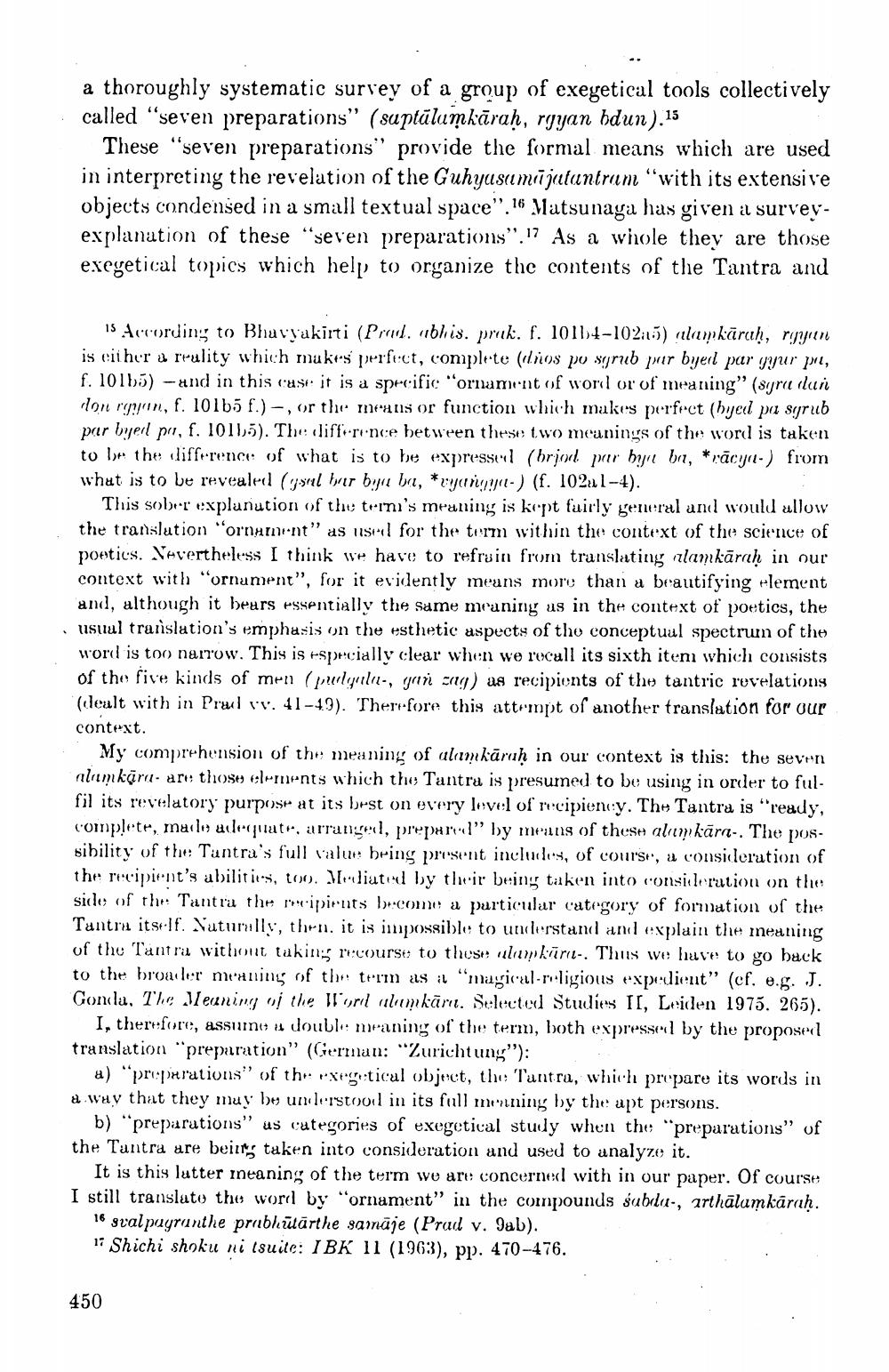Book Title: Remarks On Trantristic Hermeneutics Author(s): Ernst Steinkellner Publisher: Ernst Steinkellner View full book textPage 6
________________ a thoroughly systematic survey of a group of exegetical tools collectively called “seven preparations” (suptālumkāraḥ, rgyan bdun). 15 These "seven preparations" provide the formal means which are used in interpreting the revelation of the Guhyusumījutantrum "with its extensive objects condensed in a small textual space”. 16 Matsunaga has given a surveyexplanation of these "seven preparations”.!? As a whole they are those exegetical topics which help to organize the contents of the Tantra and 15 According to Bhavyakiti (Prod.bhis. prok. f. 10114-102:15) lampkāruh, ryyın is either a reality which makros perfect, complete (olnos po syrub par byerl par gyur p, f. 10155) - and in this case it is a sprcific ornament of word or of meaning” (syru ilun vlon rgym, f. 10165 f.)-, or the means or function which makes perfect (hycu pa syrub par byeil pui, f. 1011,5). The difference between these two meanings of the word is taken to l the difference of what is to be expresses (brjod prar byr bri, *rācyrı-) from whut is to be revealed (usual bar byrı ba, *cyangya-) (f. 102:1-4). This sober explanation of the trini's meaning is kept fairly general and would allow the translation ornament" as used for the term within the context of the science of poetics. Navertheless I think we have to refrain from translating rlamkāraḥ in our context with ornament", for it evidently means more than a beautifying -lement and, although it beurs essentially the same meaning us in the context of poetics, the . usual translation's emphasis on the esthetic aspects of the conceptual spectrum of the word is too narrow. This is especially clear when we rocall its sixth item which consists of the five kinds of men (pulynlu-, ynni cag) un recipients of the tantric revelations (dealt with in Prud vv. 41-43). Therefore this attrmpt of another translation for our context. My comprehension of the meaning of alamkāruh in our context is this: the seven alımkāru. are those el-mnts which the Tantra is presumed to be using in order to fulfil its revelatory purpose at its best on every level of recipiency. The Tantra is "ready, complete, maslo adequatr, arranged, prepare?” by means of these alım kāra.. The possibility of the Tantra's full value bring present includes, of course, a consideration of the recipient's abilities, too. N iated by their being taken into consideration on the side of the Tantra the reipients become a particular category of formation of the Tantru itself. Naturally, then, it is impossible to understand and explain the meaning of the Tantra without taking re-course to these rupkūril. Thus we have to go back to the broadler meaning of the term as it "magical-religious expedient” (cf. e.g. J. Gonda, The Jeuning oj the Iloril lumkārı. Selected Studies II, Leiden 1975. 265). I, therefore, assumne a double meaning of the term, both expressed by the proposed translation preparation" (German: "Zurichtung"): a) "preparations" of the rexegitical object, the Tantra, which prepare its words in a way that they muy be understood in its full mening by the apt persons. b) "preparations" us categories of exegetical study when the preparations” of the Tantra are being taken into consideration and used to analyze it. It is this lutter ineaning of the term we are concerned with in our paper. Of course I still translate the word by “ornament" in the compounds sublu-, arthālamkāraḥ. 16 gral payranthe prabhūtārthe samaje (Prud v. Sab). 17 Shichi shoku ni (suite: IBK 11 (1963), pp. 470-476. 450Page Navigation
1 ... 4 5 6 7 8 9 10 11 12 13 14
